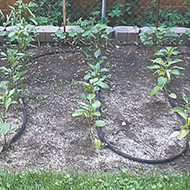Water effectively, efficiently

By Eric Barrett
OSU Extension educator
Water is essential to plant growth as well as to keep plants as productive as possible – whether it is blooms, fruit or vegetables.
Most gardeners are not watering effectively. It doesn’t help that the gardener in the commercial looks happy and the plants look healthy when water is sprayed all over the tops of them. Neither the gardener nor the plant will be happy for long.
When it comes to watering the garden and landscape, watering is important every year. Rainfall is not always consistently even and adequate. For many plants (especially fruits and vegetables), 1 inch of water is needed each week during the growing season. As the season progresses, so does the water requirement. For example, as a tomato forms on the plant, the requirement goes up to nearly 2 inches of water per week.
Watering should not be a dreaded chore that requires moving a hose, carrying a heavy bucket or trying to be outside at the correct time of day to water. Watering should be planned ahead of time to reduce the stress of it all – to make it easy.
For years, you’ve most likely heard to water in the morning, not in the evening. The reason? Moisture in the garden at night creates an environment for the growth of fungal pathogens (diseases). Applying water in the morning allows plenty of time during the day for leaves to dry. You can apply water in the afternoon if necessary, and if the water is not coming in contact with the leaves.
The Don’ts
Don’t expect to be able to use a gardening wand to water your entire garden and your pots. You’ll never give the second plant as much as the first and the last plant gets the least amount of water.
Don’t use sprinklers on anything except the lawn. And even in the lawn, think twice about why you are applying water. In July, green lawns with moisture are attractive to beetles for an area to lay their eggs, resulting in grubs.
Things to consider
Soaker hoses are a great starter for watering the garden with only the amount of water necessary for plants. This is a black, spongelike hose that allows water to seep (not spray). The seeping water provides needed water directly to the root zone. These hoses are available for about $9 for 25 feet or $13 for 50 feet. These are effective, but tend to twist. Thus, be prepared with sod staples or heavy-gauge wire to pin these down along rows in the garden. You can connect multiple soaker hoses, put them in place under mulch to be left for the entire garden season, or move them from row to row as needed.
Drip-line irrigation. Farmers call this drip tape, but it is available for the home gardener. It is very thin, flexible lines used to apply water even more slowly than soaker hoses. If your garden is about 40 x 10 feet, you can put in a drip irrigation system for about $50 to $70. Drip irrigation lines hook into your existing hose. For a very cheap price, you can add shut off values to turn off the hose for one row, while leaving the water on for another.
Timers. Watering timers are less than $15. They can be set to water plants for a specific amount of time, from 15 minutes to two hours. You’ll need to set it for each watering. For around $35, you can get a timer that turns the water on and off at different times of day or week. Both types are great time – and water-savers.
Buckets and containers. This should replace most hand watering. Use any size bucket or even a recycled milk jug. Drill one hole near the edge. Put the edge with the hole in it over the root zone of the desire plant, and then fill with water. The water seeps out slowly, giving the roots a deep watering.
Wands for watering pots. Choose a wand that reduces the pressure of the water coming out of the end. Or, simply turn down the water at the spigot. This prevents you from washing soil out of the pot.
How do you know you’ve put on 1 inch of water?
Sometimes you don’t. You’ll need to check the soil to see how effective your watering plan is working.
Use the finger test to see how deep you watered. Generally, if the water soaks down 4 to 6 inches, you’re doing an adequate job.
If you use drip tape or soaker hoses, employ a tuna can to measure. Place the can at least half way down the line, noting the time it took to fill the tuna can. This is the time it takes to water the garden with 1 inch of water.
Remember: double this amount as the season progresses.
Conserving Moisture with mulch
To keep soil from drying out, you’ll need that layer of mulch in your garden.
Everything from straw to shredded paper to grass clippings can be used.
But, we’ve found newspapers make the best mulch in the vegetable garden for many reasons. They are cheap, hold in moisture, prevent weeds and they decompose before we plant next year’s garden.
If you try this method, put your soaker hoses or drip irrigation lines down first, then cover them with four layers of newspaper, overlapping them about 4 inches to prevent separation.
To prevent the newspapers from blowing around, apply a thin layer of another mulch to hold down the newspapers (sprinkled bark mulch, grass clippings, etc).
This layering prevents splashing of soil on the plants, reducing disease.
As soon as it rains, the newspaper layers “glue” together and remain in place for the season.
For more information on watering: http://go.osu.edu/watering.
 43
43
